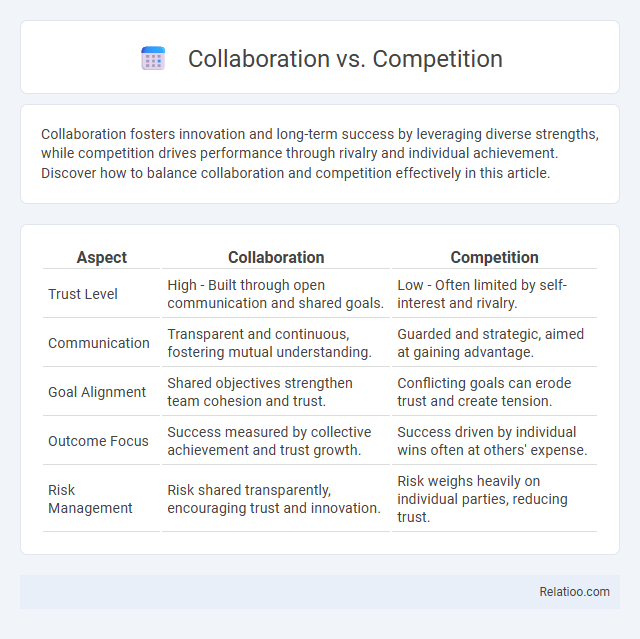Collaboration fosters innovation and long-term success by leveraging diverse strengths, while competition drives performance through rivalry and individual achievement. Discover how to balance collaboration and competition effectively in this article.
Table of Comparison
| Aspect | Collaboration | Competition |
|---|---|---|
| Trust Level | High - Built through open communication and shared goals. | Low - Often limited by self-interest and rivalry. |
| Communication | Transparent and continuous, fostering mutual understanding. | Guarded and strategic, aimed at gaining advantage. |
| Goal Alignment | Shared objectives strengthen team cohesion and trust. | Conflicting goals can erode trust and create tension. |
| Outcome Focus | Success measured by collective achievement and trust growth. | Success driven by individual wins often at others' expense. |
| Risk Management | Risk shared transparently, encouraging trust and innovation. | Risk weighs heavily on individual parties, reducing trust. |
Understanding Collaboration and Competition
Understanding collaboration involves recognizing the power of shared goals, collective problem-solving, and pooling diverse skills to achieve outcomes unattainable alone. Competition drives innovation and performance by motivating individuals or teams to excel and differentiate themselves in a market or environment. Balancing collaboration and competition fosters a dynamic ecosystem where cooperation enhances creativity while competitive pressures push for continuous improvement.
Key Differences Between Collaboration and Competition
Collaboration involves working together toward shared goals, emphasizing mutual support and resource sharing, while competition centers on outperforming others to achieve individual success or gain. Key differences include the nature of interaction--collaboration fosters collective problem-solving and synergy, whereas competition drives independent efforts fueled by rivalry. Outcomes of collaboration typically result in enhanced innovation and team cohesion, contrasting with competition's focus on ranking and individual achievement.
Benefits of Collaborative Approaches
Collaborative approaches enhance innovation by combining diverse expertise and perspectives, leading to more creative problem-solving and improved outcomes. Shared resources and knowledge accelerate project timelines and reduce costs, fostering efficiency across teams and organizations. Strong collaboration builds trust and communication, resulting in higher employee engagement and sustained long-term success.
Advantages of Competitive Environments
Competitive environments drive innovation by pushing individuals and teams to outperform rivals, fostering creativity and problem-solving skills. Your motivation and productivity often increase as you strive to achieve measurable goals and gain recognition in such settings. This dynamic promotes resilience and adaptability, essential traits for long-term success in fast-paced industries.
When to Choose Collaboration Over Competition
Choosing collaboration over competition is ideal when Your goals require leveraging diverse expertise and resources to achieve innovative solutions that one party alone cannot accomplish. Collaboration fosters knowledge sharing and collective problem-solving, enhancing productivity and long-term success in complex or evolving markets. Competition may drive short-term performance, but collaboration builds sustainable partnerships and unlocks greater value through synergy.
Challenges in Balancing Collaboration and Competition
Balancing collaboration and competition presents significant challenges as organizations strive to foster teamwork while maintaining a competitive edge. Your teams may face conflicts in sharing information openly while protecting proprietary knowledge, leading to trust issues and reduced innovation. Navigating this delicate balance requires clear communication, well-defined boundaries, and strategies that encourage cooperative goal-setting without undermining healthy competition.
Impact on Team Dynamics and Productivity
Collaboration fosters open communication and trust, enhancing team cohesion and boosting overall productivity through shared goals and diverse perspectives. Competition can drive motivation and innovation but may also create stress and conflict, potentially hindering teamwork and reducing collective efficiency. Balancing collaboration and competition strategically optimizes team dynamics by promoting healthy rivalry while maintaining mutual support and alignment with organizational objectives.
Real-World Examples: Collaboration vs Competition
Collaboration fosters innovation and efficiency in real-world settings, as seen in the tech industry where companies like Apple and IBM partnered to enhance enterprise solutions, combining strengths to achieve shared goals. Competition drives market differentiation and improvement, exemplified by Coca-Cola and Pepsi constantly innovating their products to capture consumer interest and market share. Your choice between collaboration and competition shapes organizational culture and outcomes, with strategic alliances often yielding superior long-term growth compared to isolated rivalry.
Strategies for Fostering Healthy Collaboration
Strategies for fostering healthy collaboration emphasize clear communication, shared goals, and mutual respect among team members to enhance productivity and innovation. Establishing transparent processes and encouraging diverse perspectives helps balance collaborative efforts with healthy competition, driving continuous improvement. Leveraging collaborative tools and regular feedback loops strengthens trust and alignment, ensuring teams remain focused on collective success rather than individual rivalry.
Building a Culture that Balances Competition and Collaboration
Building a culture that balances competition and collaboration requires fostering an environment where teams are motivated to achieve individual and collective goals without undermining each other. Emphasizing transparent communication, mutual respect, and shared objectives creates a dynamic where healthy competition drives innovation while collaboration ensures knowledge sharing and cohesion. Organizations that successfully integrate these elements experience increased productivity, employee engagement, and sustainable growth.

Infographic: Collaboration vs Competition
 relatioo.com
relatioo.com